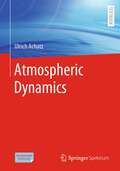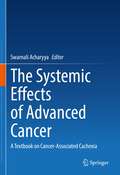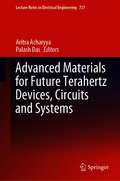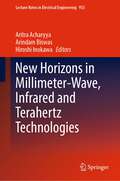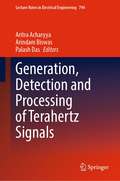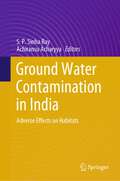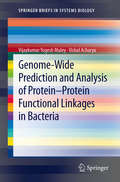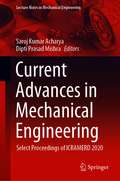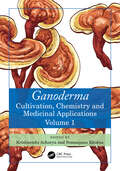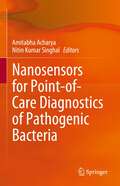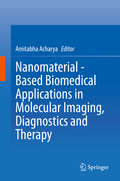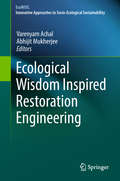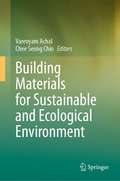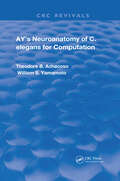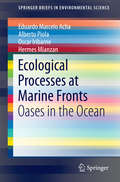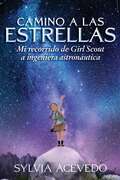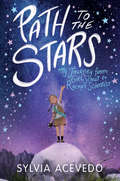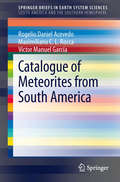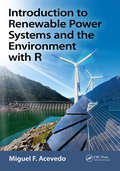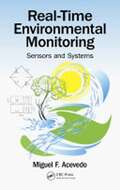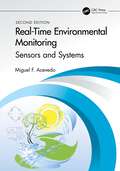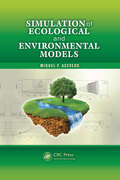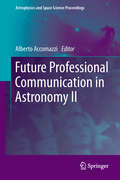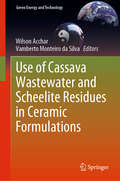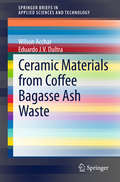- Table View
- List View
Atmospheric Dynamics
by Ulrich AchatzThis textbook is intended for both undergraduate and graduate courses in meteorology and atmospheric sciences, as well as for researchers working on theoretical and numerical aspects of weather and climate or on geophysical fluid dynamics. The treatment is concise, thorough, and self-contained. All necessary concepts are introduced, and the reader is given explicit guidance on all mathematical steps.The book begins with a derivation of the equations of motion. These are then used to discuss fundamental aspects of weather and climate. The mechanisms behind vortical motions, that are known from the daily weather map, are discussed. Shallow-water theory is introduced as a tool for an efficient analysis of key concepts, such as atmospheric waves and synoptic-scale vortices. Quasigeostrophic theory is described and then used to explain the occurrence and mechanisms of extratropical weather by means of baroclinic instability. The specific properties of the atmospheric boundary layer are discussed, with a focus on the interaction between turbulence and mean flows. This is followed by a detailed look at the global atmospheric circulation, highlighting its control by Rossby waves and gravity waves.At the same time, the reader is introduced to essential concepts that find applications in the field, such as balance by geostrophic and hydrostatic equilibrium, the role of entropy and potential temperature, potential vorticity, the Kelvin theorem, instability theory, the Reynolds equations, Eliassen-Palm and pseudo-momentum flux, multi-scale asymptotics, WKB theory, wave action, the transformed Eulerian mean, critical layers, and wave refraction.The text is supplemented by appendices on important mathematical concepts and further elaborations of the main text. Chapter summaries and reading recommendations help the reader not merely to keep focus on the essentials, but just as well to broaden the horizon.
The Systemic Effects of Advanced Cancer: A Textbook on Cancer-Associated Cachexia
by Swarnali AcharyyaThis textbook discusses the systemic consequences of cancer, covering a range of topics from tumor-promoting systemic effects to the development of cachexia, as summarized in the introductory chapter 1. Part I of this textbook focuses on tumor-promoting systemic effects and begins with a chapter on how tumor-derived extracellular vesicles and particles lay the foundation for future metastases (Chapter 2). Chapter 3 discusses how metastatic cells that have colonized the bone impact the local bone microenvironment, neighboring muscles, and host physiology. Chapter 4 summarizes the available strategies for targeting metastatic cancer and emphasizes the need to incorporate a systemic view of the disease. Following this overview of the systemic effects of cancer progression, Part II of the textbook discusses cancer-induced cachexia, a debilitating systemic effect of advanced cancer. Chapters 5-7 examine the key signaling pathways (interleukin-6/GP130, NF-kB, and muscle proteolysis) that drive the development of cancer cachexia. Chapters 8 and 9 in Part III of this textbook explore how toxicities from anti-cancer therapy are associated with the onset of cachexia in cancer patients, and provide insight into potential approaches to simultaneously target both cancer and cachexia. Chapters 10 and 11 (Part IV) conclude this textbook by outlining promising approaches for the diagnosis and treatment of cachexia as well as strategies to prevent the development of cachexia through exercise. An understanding of the systemic effects of cancer is essential for the design of effective anti-cancer and anti-cachexia treatment strategies. As such, this textbook provides key information for both students and scientists engaged in cancer research and oncology.
Advanced Materials for Future Terahertz Devices, Circuits and Systems (Lecture Notes in Electrical Engineering #727)
by Aritra Acharyya Palash DasThis book highlights the properties of advanced materials suitable for realizing THz devices, circuits and systems, and processing and fabrication technologies associated with those. It also discusses some measurement techniques exclusively effective for THz regime, newly explored materials and recently developed solid-state devices for efficient generation and detection of THz waves, potentiality of metamaterials for implementing THz passive circuits and bio-sensors, and finally the future of silicon as the base material of THz devices. The book especially focuses on the recent advancements and several research issues related to THz materials and devices; it also discusses theoretical, experimental, established, and validated empirical works on these topics.
New Horizons in Millimeter-Wave, Infrared and Terahertz Technologies (Lecture Notes in Electrical Engineering #953)
by Aritra Acharyya Arindam Biswas Hiroshi InokawaThis book presents recent and upcoming technological advancements in millimeter-wave (mm-wave), infrared (IR) and terahertz (THz) frequency spectrums. The scope of this book includes a significantly long portion of the electromagnetic spectrum, starting from the mm-waves (i.e. 30 GHz) and extended up to the end of the near-IR spectrum (i.e. 450 THz). Most significant aspect of this portion of the electromagnetic spectrum is that it includes a frequency regime where the gradual technological transition from electronics to photonics occurred. The book especially focuses on the recent advancements and several research issues related to materials, sources, detectors, passive circuits, advanced signal processing and image processing algorithms for mm-wave, IR and THz frequency bands. The book covers a very wide range of readers from basic science to technological experts as well as research scholars.
Generation, Detection and Processing of Terahertz Signals (Lecture Notes in Electrical Engineering #794)
by Aritra Acharyya Arindam Biswas Palash DasThis book contains detailed descriptions and associated discussions regarding different generation, detection and signal processing techniques for the electrical and optical signals within the THz frequency spectrum (0.3–10 THz). It includes detailed reviews of some recently developed electronic and photonic devices for generating and detecting THz waves, potential materials for implementing THz passive circuits, some newly developed systems and methods associated with THz wireless communication, THz antennas and some cutting-edge techniques associated with the THz signal and image processing. The book especially focuses on the recent advancements and several research issues related to THz sources, detectors and THz signal and image processing techniques; it also discusses theoretical, experimental, established and validated empirical works on these topics. The book caters to a very wide range of readers from basic science to technological experts as well as students.
Ground Water Contamination in India: Adverse Effects on Habitats
by Achiransu Acharyya S. P. Sinha RayThis book examines contamination in groundwater. Groundwater is a lifeline for most countries of the world. 90% of the Indian population rely on groundwater-based drinking water as safe mode of water supply. The terminology contamination in groundwater along with adverse effect on habitats, suggests the impact of such contamination in not only for drinking water, but also for agricultural irrigation. In addition, polluted groundwater causes adverse health hazards including social aspects that affect wider communities. Impacts on plant life also are equally threatening. This book provides readers with an insight into groundwater contamination in India. The economic loss associated with this devastating phenomenon is also studied in detail, which has a direct bearing to the country's GDP.
Genome-Wide Prediction and Analysis of Protein-Protein Functional Linkages in Bacteria
by Vishal Acharya Vijaykumar Yogesh MuleyUsing genome sequencing, one can predict possible interactions among proteins. There are very few titles that focus on protein-protein interaction predictions in bacteria. The authors will describe these methods and further highlight its use to predict various biological pathways and complexity of the cellular response to various environmental conditions. Topics include analysis of complex genome-scale protein-protein interaction networks, effects of reference genome selection on prediction accuracy, and genome sequence templates to predict protein function.
Current Advances in Mechanical Engineering: Select Proceedings of ICRAMERD 2020 (Lecture Notes in Mechanical Engineering)
by Saroj Kumar Acharya Dipti Prasad MishraThis book presents select proceedings of the International Conference on Recent Advances in Mechanical Engineering Research and Development (ICRAMERD 2020). The contents focus on latest research and current problems in various branches of mechanical engineering. Some of the topics discussed here include fracture and failure analysis, fuels and alternative fuels, combustion and IC engines, advanced manufacturing technologies, powder metallurgy and rapid prototyping, industrial engineering and automation, supply chain management, design of mechanical systems, vibrations and control engineering, automobile engineering, fluid mechanics and machines, heat transfer, composite materials, micro and nano-engineering for energy storage and conversion, and modeling and simulations. The wide range of topics presented in this book can make it useful for beginners, researchers as well as professionals in mechanical engineering.
Ganoderma: Cultivation, Chemistry and Medicinal Applications, Volume 1
by Krishnendu Acharya Somanjana KhatuaGanoderma holds significant traditional importance in various ethnic cultures around the world, particularly in China, Japan, and Korea. Many indigenous traditions have incorporated Ganoderma into medicinal practices, being considered a symbol of longevity, vitality, and good health. At present, the taxon is believed to possess various health benefits and is used to treat ailments and promote overall well-being. In this context, the first volume of the book, titled Ganoderma: Cultivation, Chemistry and Medicinal Applications, aims to comprehensively cover the taxonomy, morphological features, domestication strategies, structures of secondary metabolites, and therapeutic prospects of Ganoderma. It may serve as a definite resource for students, researchers, healthcare professionals, traditional medicine practitioners, and enthusiasts.FEATURES Provides a comprehensive classification system for Ganoderma species, highlighting their taxonomy and distinguishing characteristics Delves into the techniques and practices involved in cultivating Ganoderma, offering detailed guidance for individuals interested in growing this valuable fungus Explores the cultural and traditional significance of Ganoderma in various ethnic cultures intertwined with customs, beliefs, rituals, myths, and folklore around the world Investigates the secondary metabolites of Ganoderma, highlighting their implications Examines diverse bioactivities associated with Ganoderma, including antioxidant, hepatoprotective, antidiabetic, prebiotic, anti-inflammatory, anti-arthritis, anticancer, hypolipidemic, and cholesterol-lowering effects This book includes relevant illustrations, diagrams, and images to enhance the understanding of concepts associated with Ganoderma.
Nanosensors for Point-of-Care Diagnostics of Pathogenic Bacteria
by Amitabha Acharya Nitin Kumar SinghalThis book comprehensively reviews various nanodiagnostic approaches for the detection of bacterial pathogens. The initial chapter of the book discusses receptors present on bacterial cell surfaces that can be targeted for diagnostic applications. The book then presents different fluorescent nanoparticle systems that are used for bacterial detection. Further, it covers surface plasmon resonance (SPR), ELISA, and QCM-based nanosensors to detect pathogenic bacteria. It examines different nanosensors used for the microfluidic-based detection of bacterial pathogens, including microfluidic paper-based analytical devices (μPADs), lateral flow devices, and miniaturized PCR devices. The book also covers the current electrochemical, voltammetric, and amperometric nanosensors-based microorganism recognition approaches. Lastly, the book summarizes the current challenges and the futuristic application of nanosensors to detect bacterial pathogens. This book is an invaluable resource for all medical laboratories and clinical institutions dealing with infectious diseases.
Nanomaterial - Based Biomedical Applications in Molecular Imaging, Diagnostics and Therapy
by Amitabha AcharyaThis book comprehensively reviews the recent advances in nanomaterial-based molecular imaging, diagnostics, and personalized therapy. It discusses the novel biocompatible fluorescent nanomaterials, their synthesis, and modern state of art characterization, as well as the various strategies for immobilization of biomacromolecules on the nanomaterial surface and approaches for increasing their stability. In addition, the book describes the synthesis of lectin nanoconjugates using different types of biocompatible raw materials and their systematic characterization. Lastly, it presents our current understanding of the biomolecular carona, which affects nanoparticle-based targeted drug delivery, and examines the conceptual approaches to improve the in-vivo efficacy of targeted drug delivery.
Ecological Wisdom Inspired Restoration Engineering (EcoWISE)
by Varenyam Achal Abhijit MukherjeeThis book focuses on ecological wisdom inspired restoration engineering through theories, hypotheses, policies, practical understanding, and case studies. Understanding nature’s processes is a prerequisite for the healthy and sustainable functioning of a habitable Earth. As such, the book provides a guide for readers seeking to understand and build sustainable, urban socio-ecological systems using restoration technologies based on wisdom. Motivated by recent rapid advances in restoration engineering, such as the role of green building materials in urban infrastructures, and developing sustainable landscapes to benefit the environment, economy and communities, it is an essential reference on the most promising innovative technologies. It discusses engineering methods and practices in the restoration of soil, water, heritage sites, and other ecosystems, as well as the development and applications of green building materials. It presents a holistic and systematic approach that utilizes natural resources and the concept of ecological wisdom to reap sustainable environmental, economic and social benefits to fulfill the concept of living in harmony with nature. This book is a valuable resource for civil- and environmental engineering researchers as well as organizations engaged in eco-restoration practices.
Building Materials for Sustainable and Ecological Environment
by Varenyam Achal Chee Seong ChinThis book uses theories, hypotheses, policies, practical insights and case studies to introduce and elucidate green building materials for sustainable construction. Cement is the most widely used building material in construction; however, it is not sustainable, being responsible for 7% of global carbon dioxide emissions and consuming huge quantities of energy. In order to limit the ecological damage, sustainable building materials are needed. Ecosystems are a source of important lessons and models for transitioning the built environment onto a sustainable path that opens options for sustainable building material in construction. The book provides a guide for readers seeking knowledge on sustainable building materials with the potential to lower environmental impact by reducing CO2 emission throughout the building’s lifecycle. The book is motivated by recent rapid advances in sustainable building materials production, including green building materials made of industrial by-products and recycled wastes, earth materials, plant-based materials, microbial-based materials or supplementary cementitious materials, to reduce the environmental impacts of traditional building materials. Discussing the development and applications of various sustainable building materials, including related case studies, and addressing the environmental issue with a holistic and systematic approach that creates an ecology of construction for sustainability in infrastructures, it offers promising solutions to achieve renewable and sustainable building materials for the future.
Ay's Neuroanatomy of C. Elegans for Computation (Routledge Revivals)
by Theodore B. Achacoso William S. YamamotoFirst published in 1992, AY's Neuroanatomy of C. elegans for Computation provides the neural circuitry database of the nematode Caenorhabditis elegans, both in printed form and in ASCII files on 5.25-inch diskettes (for use on IBM® and compatible personal computers, Macintosh® computers, and higher level machines). Tables of connections among neuron classes, synapses among individual neurons, gap junctions among neurons, worm cells and their embryonic origin, and synthetically derived neuromuscular connections are presented together with the references from which the data were compiled and edited. Sample data files and source codes of FORTRAN and BASIC programs are provided to illustrate the use of mathematical tools for any researcher or student interested in examining a natural neural network and discovering what makes it tick.
Ecological Processes at Marine Fronts
by Eduardo Marcelo Acha Alberto Piola Oscar Iribarne Hermes MianzanThis book reviews and summarizes the results and hypotheses raised by studies directly or indirectly dealing with the ecology of fronts and aims to identify the themes that connect them to produce a synthesis of this knowledge. Though not immediately perceived the ocean is highly structured and fronts are one of the most important components of its structural complexity. Marine fronts have been known since the early 20th Century, however, the more recent availability of high resolution satellite imagery, field measurements and numerical simulations have greatly advanced our understanding of their ecological impact. This work touches on topics such as front types, its biology and its comparisons with other bounderies at sea, as well as comparisons of fronts with terrestrial boundaries and the 'ecotone' concept. Furthermore, it also looks at the management and conservation of marine life.
Camino a las estrellas (Path to the Stars Spanish edition): mi recorrido de Girl Scout a ingeniera astronáutica
by Sylvia Acevedo Isabel MendozaUna familia cariñosa, un vecindario repleto de niños y una mamá que cantaba todo el día… Sylvia Acevedo amaba todo lo que tenía en la vida. Un día se enfermó su hermanita, y todo cambió.Mientras su familia luchaba por salir adelante después de esa devastadora enfermedad, la vida de la pequeña Sylvia se transformó cuando ingresó a las Brownies. En Girl Scouts le enseñaron a crear sus propias oportunidades. La ayudaron a planificar su futuro y alimentaron su amor por los números y la ciencia.Con renovada seguridad, Sylvia navegó a través de las diferentes expectativas culturales de su escuela y su hogar, abriéndose su propio camino hasta convertirse en una de lxs primerxs latinx en obtener una maestría en ingeniería de la Universidad de Stanford y en una de las pocas ingenieras astronáuticas en el Laboratorio de Propulsión a Chorro de la NASA. ¡Disponible en español y ingles! Sylvia Acevedo es actualmente la Directora Ejecutiva de Girl Scouts de Estados Unidos. Su inspiradora historia, contada con calidez y perspicacia, alienta a los lectores a soñar en grande y a convertir sus sueños en realidad.
Path to the Stars: My Journey from Girl Scout to Rocket Scientist
by Sylvia AcevedoThe inspiring memoir for young readers about a Latina rocket scientist whose early life was transformed by joining the Girl Scouts and who currently serves as CEO of the Girl Scouts of the USA.A meningitis outbreak in their underprivileged neighborhood left Sylvia Acevedo’s family forever altered. As she struggled in the aftermath of loss, young Sylvia’s life transformed when she joined the Brownies. The Girl Scouts taught her how to take control of her world and nourished her love of numbers and science. With new confidence, Sylvia navigated shifting cultural expectations at school and at home, forging her own trail to become one of the first Latinx to graduate with a master's in engineering from Stanford University and going on to become a rocket scientist at NASA’s Jet Propulsion Laboratory. Simultaneously available in Spanish!
Catalogue of Meteorites from South America (SpringerBriefs in Earth System Sciences)
by Rogelio Daniel Acevedo Maximiliano C. L. Rocca Víctor Manuel GarcíaThe first Catalogue of Meteorites from South America includes new specimens never previously reported, while doubtful cases and pseudometeorites have been deliberately omitted. The falling of these objects is a random event, but the sites where old meteorites are found tend to be focused in certain areas, e. g. in the deflation surfaces in Chile's Atacama Desert, due to favorable climate conditions and ablation processes. Our Catalogue provides basic information on each specimen like its provenance and the place where it was discovered (in geographic co-ordinates and with illustrative maps), its official name, its classification type (class, and if applicable, weathering grade and shock stage), if it was seen falling or was found by chance, its total mass or weight, the institution where it is held, and the most important bibliographic references about it.
Introduction to Renewable Power Systems and the Environment with R
by Miguel F. AcevedoThis textbook introduces the fundamentals of renewable electrical power systems examining their direct relationships with the environment. It covers conventional power systems and opportunities for increased efficiencies and friendlier environmental interactions. While presenting state-of-the-art technology, the author uses a practical interdisciplinary approach explaining electrical, thermodynamics, and environmental topics within every chapter. This approach allows students to feel comfortable moving across these disciplines. The added value are the examples of software programs using open source systems which serve as learning tools for the concepts and techniques described in the book.
Real-Time Environmental Monitoring: Sensors and Systems
by Miguel F. AcevedoThe natural environment is complex and changes continuously at varying paces. Many, like the weather, we notice from day to day. However, patterns and rhythms examined over time give us the bigger picture. These weather statistics become climate and help us build an understanding of the patterns of change over the long term. <p><p> Real-Time Environmental Monitoring: Sensors and Systems introduces the fundamentals of environmental monitoring, based on electronic sensors, instruments, and systems that allow real-time and long-term data acquisition, data-logging, and telemetry. <p><p> The book details state-of-the-art technology, using a practical approach, and includes applications to many environmental and ecological systems. In the first part of the book, the author develops a story of how starting with sensors, you can progressively build more complex instruments, leading to entire systems that end with databases and web servers. In the second part, he covers a variety of sensors and systems employed to measure environmental variables in air, water, soils, vegetation canopies, and wildlife observation and tracking. <p><p> This is an emerging area that is very important to some aspects of environmental assessment and compliance monitoring. Real-time monitoring approaches can facilitate the cost effective collection of data over time and, to some extent, negate the need for sample, collection, handling, and transport to a laboratory, either on-site or off-site. It provides the tools you need to develop, employ, and maintain environmental monitors.
Real-Time Environmental Monitoring: Sensors and Systems - Textbook
by Miguel F. AcevedoWritten 10 years after the publication of the first edition, this updated edition of Real-Time Environmental Monitoring: Sensors and Systems introduces the fundamentals of environmental monitoring based on electronic sensors, instruments, systems, and software that allow continuous and long-term ecological and environmental data collection. It accomplishes two objectives: explains how to use sensors for building more complex instruments, systems, and databases, and introduces a variety of sensors and systems employed to measure environmental variables in air, water, soils, vegetation canopies, and wildlife observation and tracking. This second edition is thoroughly updated in every aspect of technology and data, and each theoretical chapter is taught parallel with a hands-on application lab manual. Emphasizes real-time monitoring as an emerging area for environmental assessment and compliance and covers the fundamentals on how to develop sensors and systems Presents several entirely new topics not featured in the first edition, including remote sensing and GIS, machine learning, weather radar and satellites, groundwater monitoring, spatial analysis, and habitat monitoring Includes applications to many environmental and ecological systems Uses a practical, hands-on approach with the addition of an accompanying lab manual, which students can use to deepen their understanding, based on the author’s 40 years of academic experience Intended for upper-level undergraduate and graduate students, taking courses in civil and environmental engineering, electrical engineering, mechanical engineering, geosciences, and environmental sciences, as well as professionals working in environmental services, and researchers and academics in engineering.
Simulation of Ecological and Environmental Models
by Miguel F. AcevedoGiven the importance of interdisciplinary work in sustainability, Simulation of Ecological and Environmental Models introduces the theory and practice of modeling and simulation as applied in a variety of disciplines that deal with earth systems, the environment, ecology, and human-nature interactions. Based on the author's many years of teaching g
Future Professional Communication in Astronomy II
by Alberto AccomazziThe present volume gathers together the talks presented at the second colloquim on the Future Professional Communication in Astronomy (FPCA II), held at Harvard University (Cambridge, MA) on 13-14 April 2010. This meeting provided a forum for editors, publishers, scientists, librarians and officers of learned societies to discuss the future of the field. The program included talks from leading researchers and practitioners and drew a crowd of approximately 50 attendees from 10 countries. These proceedings contain contributions from invited and contributed talks from leaders in the field, touching on a number of topics. Among them: - The role of disciplinary repositories such as ADS and arXiv in astronomy and the physical sciences; - Current status and future of Open Access Publishing models and their impact on astronomy and astrophysics publishing; - Emerging trends in scientific article publishing: semantic annotations, multimedia content, links to data products hosted by astrophysics archives; - Novel approaches to the evaluation of facilities and projects based on bibliometric indicators; - Impact of Government mandates, Privacy laws, and Intellectual Property Rights on the evolving digital publishing environment in astronomy; - Communicating astronomy to the public: the experience of the International Year of Astronomy 2009.
Use of Cassava Wastewater and Scheelite Residues in Ceramic Formulations (Green Energy and Technology)
by Wilson Acchar Vamberto Monteiro da SilvaThis book presents original results on the use of cassava wastewater as a substitute for potable water in ceramic formulations. It evaluates the physical and mechanical properties as well as the microstructure of the materials produced, comparing the products obtained from the incorporating effluent with the conventional materials used in the construction industry.
Ceramic Materials from Coffee Bagasse Ash Waste (SpringerBriefs in Applied Sciences and Technology)
by Wilson Acchar Eduardo J. V. DultraThis book proposes the use of coffee bagasse ash (CBA) waste as raw material to be used in ceramic formulations. The approach presented here is a solution to a current ambiental problem as CBA waste is discharged in high amounts in agriculture. The authors analyze the potencial of CBA as a material to substitute feldspar in tile production.
